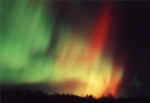
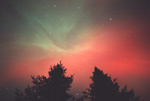
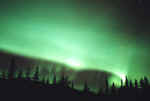

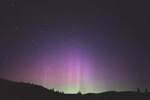
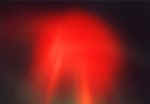

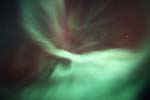

|
Northern
lights chaser
by Dominic Cantin
A
few years ago, under a beautiful starry night of March, I was in the
Laurentides Wildlife Reserve, 100 km north of Quebec City,
photographing the stars, when suddenly, I saw a green gleam
appearing in the sky in a northward direction. I wondered what could
be this light in the shape of an arc with white rays that reached
upward, moving slowly to the right and left: I was witness to my
first aurora borealis! Thereafter, I often returned to the park of
the Laurentides, hoping to again observe these famous lights.
Sometimes there were aurorae, but most of the time, the sky was
"only" starry. After the arrival of the Internet and
several researches later, I discovered that the aurorae were
foreseeable! We can observe this phenomenon in the northern
hemisphere (aurora borealis) or the southern hemisphere (aurora
australis).
Several
auroral shapes can be observed: there are the homogeneous bows, the
arcs with rays, the wavy strips, the curtains and the crowns or
coronae (aurorae that occur overhead directly above). These shapes
depend on the solar activity: the more the Sun is "silent"
with a quiet solar wind, the less the auroral oval is big;
contrarily, the more the solar wind hits the terrestrial magnetic
field with strength and gusts, the more the aurora becomes large and
spreads.
Contrary
to popular belief, the aurorae are not due to reflections of the Sun
on the big glaciers of the north, but are really the result of the
solar wind that interacts with the terrestrial atmosphere. When
solar eruptions occur, many particles are projected into space. It
is what is called the solar wind. Normally, it blows 250 to 300
km/second around the Earth, but when there is a solar eruption that
makes a path toward us, this wind can increase up to (for example)
700 km/second when it often provokes some aurora borealis.
On
the surface of the Sun, sunspots - which are regions with unsettled
magnetic fields - can be the theater of solar eruptions. Depending
upon the speed, one of these eruptions will take between 1 and 3
days to arrive at the Earth.
The
frequency of the eruptions is greater at the time of the peaks of
activity of the Sun that repeat approximately every 11 years. 2000
was the year of the solar maximum. I call here on your memories: On
March 13, 1989, an eruption came to flood the Earth and made crash
simultaneously the whole electric network of Hydro Quebec, depriving
9 million Canadians of electricity for several hours... Some people
told me that they had seen aurora borealis of mauve color (purple)
in the sky of Quebec at the time of this electric breakdown! Do you
remember it? One thing is sure, that when you are able to see a
beautiful aurora borealis, you will remember it for a long time !
The
Earth is like a big magnet that produces a magnetic field offering a
natural protection named the magnetosphere. Just beyond Earth it
acts as a shield to protect us against the solar wind (particle
stream) so that the terrestrial atmosphere is not blown by these
strong winds. When there is a solar eruption, charged
particles (protons and electrons) penetrate the magnetosphere
barrier. However, because they are charged by electricity, these
particles are attracted by the magnetic poles of the Earth: the
north pole and the south pole.
A
certain quantity will follow the lines of the magnetic field
therefore to enter in contact with the atmosphere. The particles
from the Sun enter then in collision with molecules of gas and,
according to the layer of the atmosphere that will be ionized, we
will have different colors. When the particles enter in collision
with the atmospheric gases, mainly oxygen and nitrogen, the oxygen
will emit the green, and red (usually higher up) colors while
nitrogen will give the colors dark red and purple. Yellow
results from the mixing of red and green.
The
visible colors are most frequently the green and the white. But on
photographic film, the red can appear without you having seen it
with the naked eye! When there is a magnetic storm, the red is
easily visible as well as other colors such as purple and pink.
Quebec is an excellent place for the observation of the aurora
although it is necessary to move away somewhat northwards, east or
west, to avoid the lights of the big cities. A strong aurora
borealis can be seen in full city lights, but rare are such
opportunities and better are the details to be seen far from the
luminous pollution. Alaska and the Yukon (and northern Norway and
Finland) are among the best places in the world for the observation
of the aurora borealis with an average of 200 nights "inflamed"
per year at the time of the solar maximum. The Big North Quebecois
(far northern Quebec) is also an excellent place to admire these
plays of lights. Some people who went there told me that the people
who live in these regions got so used to the auroras borealis that
they don't make much of it any more, a pity!
On
October 28, 2001, toward 23:00, I phoned one of my friends to tell
to him that an aurora was going to occur that night and that we were
going to attend a beautiful spectacle, surely. He first of all
answered me that he was not able to, but by dint of insistence, I
convinced him while telling him that I would be going to look for it
at home. Arriving at the island of Orleans (30 km to the East of the
city of Quebec) we saw a green distorted bow or arc in the northern
direction. I knew from experience that something bigger had to occur:
the mass ejected 34 hours earlier from the Sun had not yet arrived.
One hour later, we began to see the red in this aurora that
increased in size as time advanced. Suddenly, a "wall of
light" stood above our heads! It was in the shape of a dome,
red at the lowest part, green in the center and red above; it passed
from the east horizon to the west horizon. We were stunned
completely by the strength of this aurora! We held on to each
other's shoulders while jumping and shouting. We seemed to be two
"nuts" in this field on the island of Orleans The red of
this aurora was visible during the entire night at different
intensities. My friend thanked me repeatedly for having insisted a
little so that he should come with me! That evening I didn't have
enough film because I "only" had in reserve four rolls of
24 frames each. It was an unforgettable magnetic storm!
To
take pictures of the aurora borealis is a possible and accessible
thing by all, that requires standard photo equipment: one camera
adjustable by hand (I use a Pentax K1000), in the B (bulb) position,
as well as a tripod, and a sensitive enough film (400 or 800 ISO), a
lens of 50 mm or 28 mm set to the biggest aperture (f/1.7 or f/2.8)
and a flexible cable release. According to the speed of the movement
of the aurora and its intensity, the times of exposures will vary
between 15 and 25 seconds. But nothing prevents making the exposure
times longer or shorter. I use 25 seconds of exposure the most often.
The
best times of the year to observe this phenomenon are the spring (from
March to May) and the fall (from September to November) but nothing
prevents seeing it in summer (unless you live very far north) or in
winter. An aurora can be observed early in the evening or late at
night, but in general, midnight is the best hour. To be a witness of
the fantastic spectacle which is the aurora borealis, it is
necessary that all ingredients are in place: a big enough solar
eruption to blow us its "dusts", the magnetosphere that
tilts against the current when the cloud of plasma arrives, a clear
sky, in short enough luck!
Some
advice for the photographer of aurora : when you will be in front of
an aurora borealis with your photo equipment, don't panic; don't try
to take all shots at the same time because it is at this moment that
one misses his stroke! Rather try to center your picture in the
horizontal or the vertical, with as much sky as possible, including
some trees (far or near) in the foreground, or a chalet or even
people who won't move during 25 seconds (while sending them a flash
mental picture to keep still). Having several rolls of film will
avoid some frustrations (I use the Fuji Superia X-tra 800 a lot, but
I know that several people take this kind of picture in slide format
using Fuji Provia 400). Let go your artistic side !
Several
Internet sites offer some information on the aurora, here are some: www.spaceweather.com,
www.spacew.com, www.northern-lights.no, http://sohowww.nascom.nasa.gov. |
|
*
Thanks to Amber Rahm for her kind help for the translation of this
text.
|
|
|